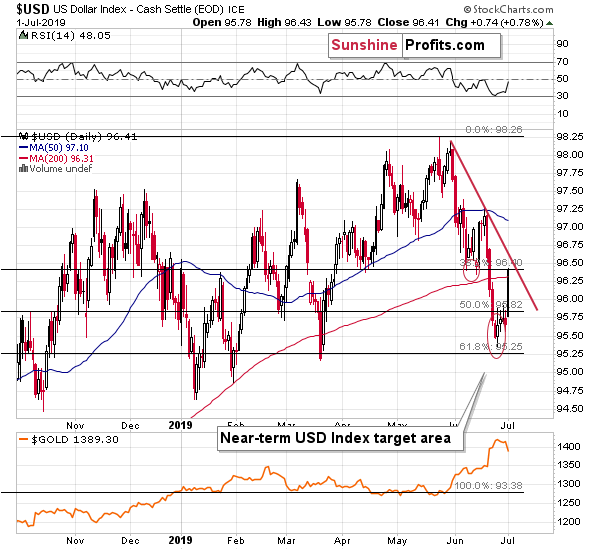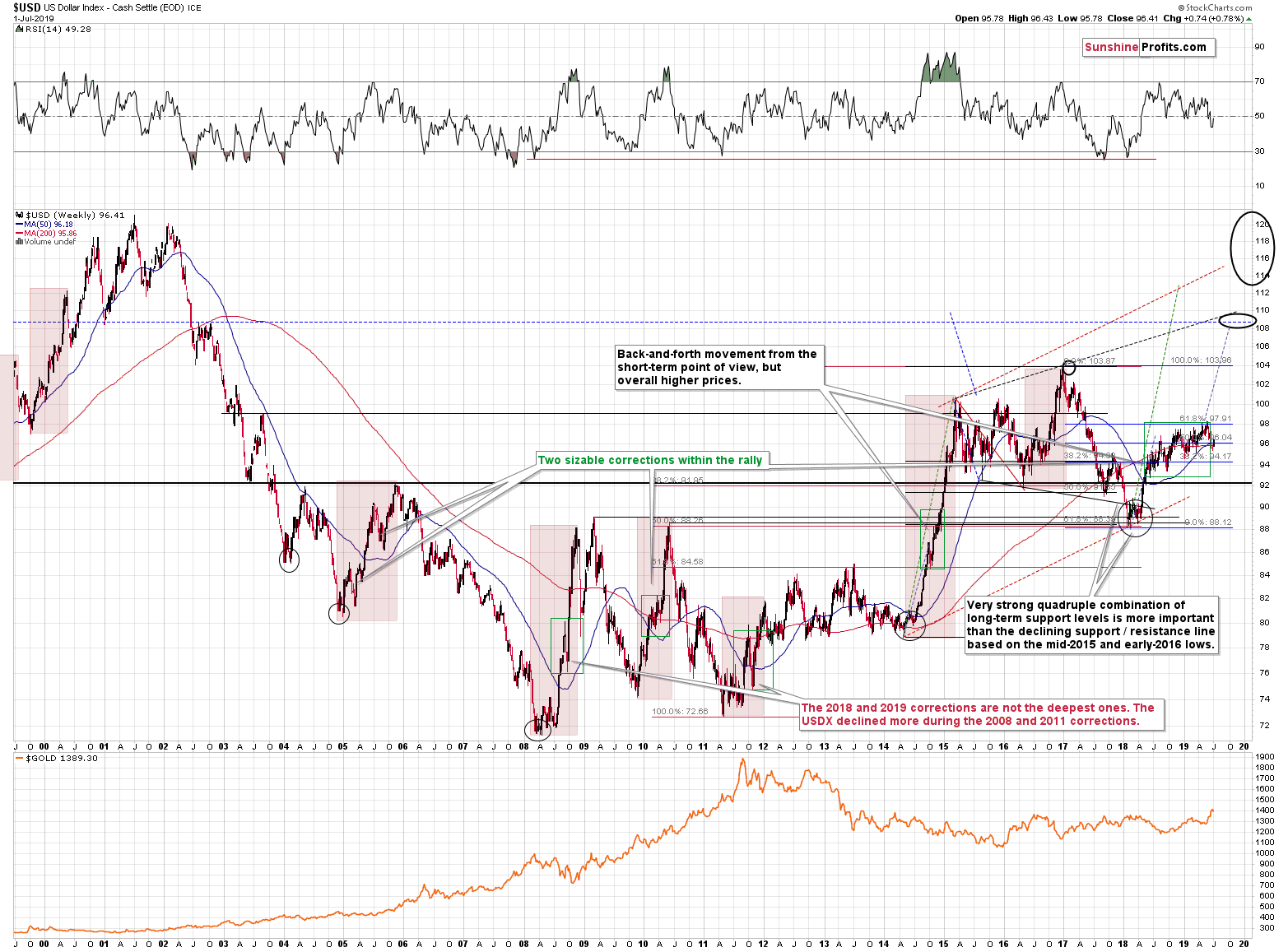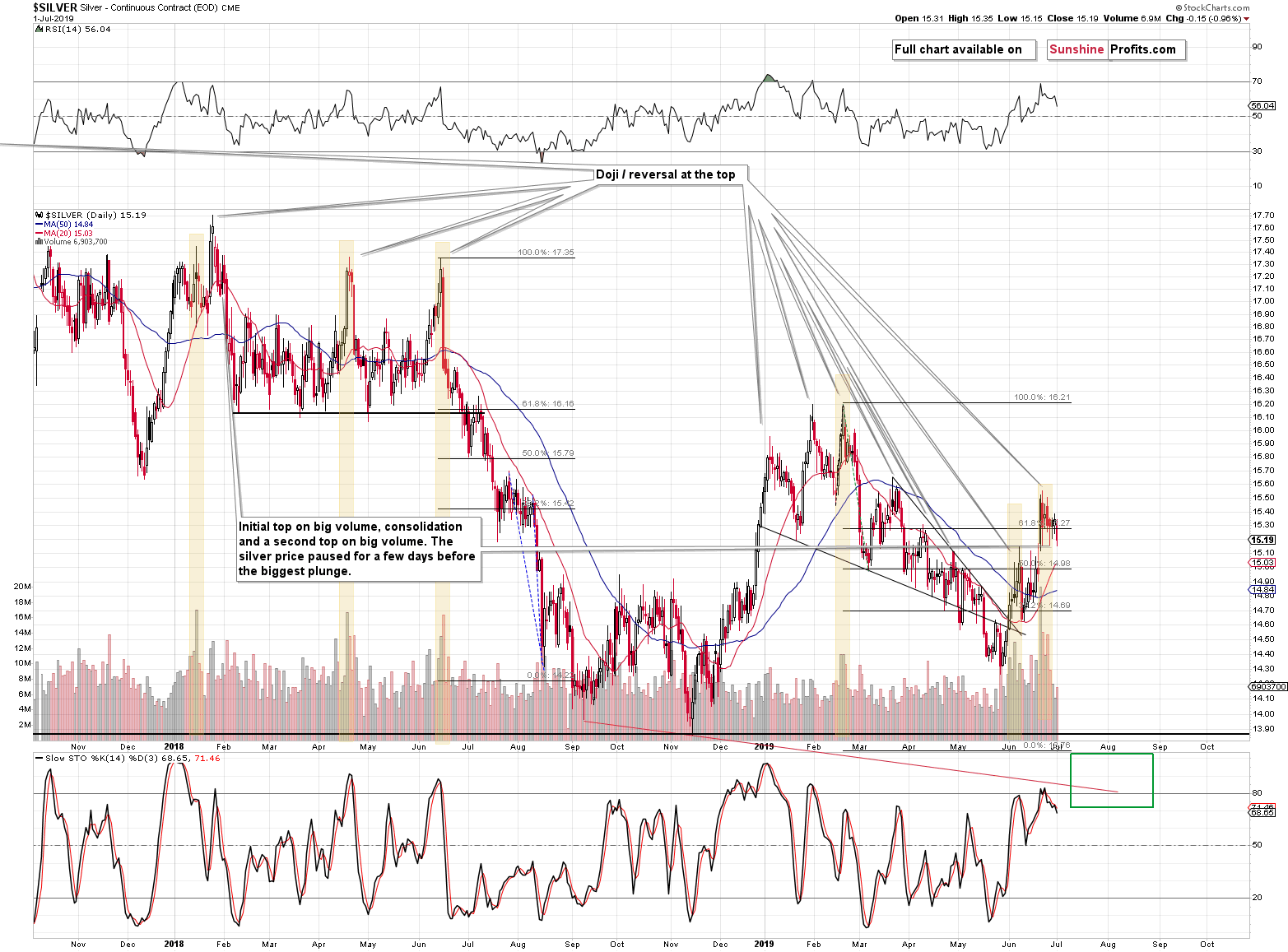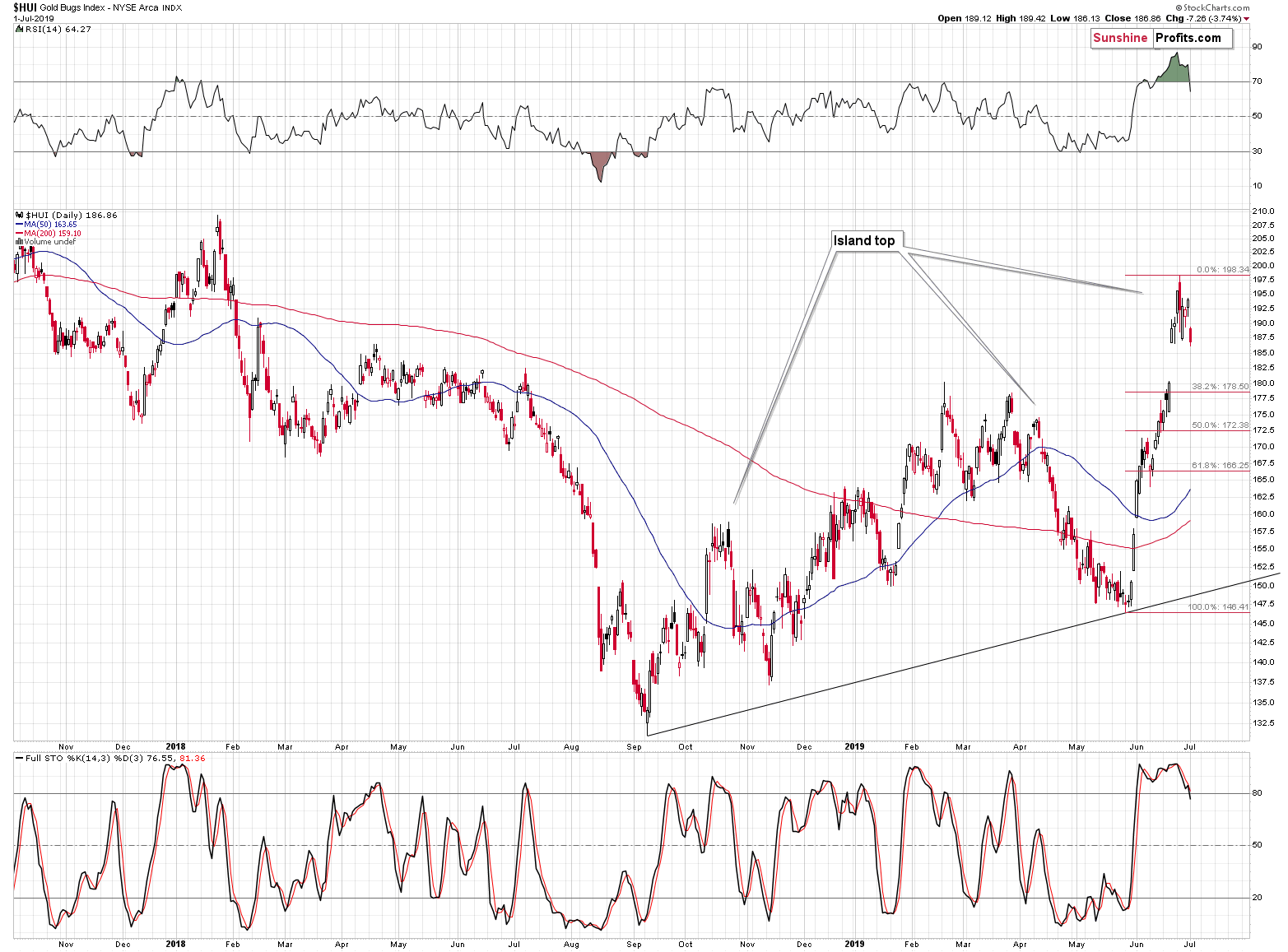Briefly: in our opinion, full (250% of the regular size of the position) speculative short position in gold, silver, and mining stocks are justified from the risk/reward perspective at the moment of publishing this Alert.
Gold didn't just move below $1,400 temporarily - it closed there. The yellow metal has therefore invalidated the move above this level, and - more importantly - it invalidated the breakout above the mid-2013 weekly closing high. This is already profound by itself, but if you wait several more days, there'll be more to come. You'll see even more overwhelming developments in the gold market. Unfortunately, after the dust settles and the most volatile price swings are over, the easiest (to trade) part of this move will be over...
Let's take a look at the gold chart for details. Yesterday, we focused on the long-term charts, so the focus of today's analysis our will be the short-term changes.
Gold at Short-term Support
Gold declined and it did so on volume that was higher than what we saw on the preceding day, which confirmed the bearish directions. Now, what is particularly interesting is the position of gold relative to the short-term rising support line that we marked with black.
It's true that the most important thing was last week's immediate invalidation of the breakout above the intraday mid-2013 high, and that yesterday's close below $1,400 already served as a confirmation of the turnaround (along with multiple indications that we saw beforehand, such as extremely big volume and triangle-vertex-based reversals). However, many people ignore the bigger picture and focus on the most recent changes. This is even true for people posting their analyses publicly, which is the likely reason why people got overly excited after gold moved above the 2018 highs while silver didn't even move close to its 2019 highs.
The above means that even though the most important signs are already behind us, most people may not realize that. What they do realize is that gold moved to the short-term support line and it didn't decline below it. These people may buy some more and trigger another - smaller - upswing that attempts to take gold back above $1,400 on a closing basis. But it's not likely that they will manage to do anything more than that - after all, the true turnaround has already taken place as confirmed by the many signs.
The implications are that gold may attempt to get back above $1,400 today, and that the decline is likely to accelerate once gold breaks below the rising support line. This line is currently at about $1,385, so a daily close below it should trigger waterfall selling on the next day.
Let's see how the above compares to the USD Index chart.
USD Index Bounces Higher
In short, gold's decline to its rising support line perfectly corresponds to US dollar's move sharply higher, but not above its own declining resistance line. On many occasions we emphasized and showed examples of situations when gold waited for the USD Index to either break out or break down, before taking real action. The same thing could be the case now. Consequently, the biggest moves are still ahead.
Before moving to silver, please note where the USD Index is right now, despite the multiple bearish surprises on the geopolitical front, and despite much more dovish Fed along with Trump's I-want-lower-USD comments. This year's low is 94.64, and this year's high is 98.26. Their average - the midpoint - is 96.45. Yesterday's close was 96.41. Despite all these bearish factors, the USD Index is in the middle of the year's trading range - it's not making new lows; it's not even trading close to the yearly low.
The USD Index is much stronger than it seems by just looking at the above chart. That short-term chart misses the full context.
And the context is that all the above-mentioned bearish factors for the USD Index were unable to trigger a breakdown from the rising consolidation pattern (making it a running correction - the most bullish kind of correction), let alone cause a severe decline. The implication is that the USD Index is very likely to break from the current consolidation to the upside and move considerably higher before stopping - most likely well above the 2016 highs. The implications for gold, silver and mining stocks are very bearish.
Speaking of silver, let's take a look at white metal's chart. Then, we'll move onto the mining stocks.
Silver and Mining Stocks in Focus
Silver moved lower yesterday, but it didn't move lower profoundly. The key word here is "yet". Silver's recent performance falls into the "normal" category of price moves based on what we already saw in the previous months.
In particular, the analogy to what happened in early 2018 appears useful. The reason is that both declines were preceded by similar rallies. In both cases, we initially saw a rally that ended with a big-volume reversal, then a small decline and then another rally - to new highs - that ended with relatively big volume as well.
The early 2018 decline started by a move lower that erased just the final part of the decline, then we saw a few days of back and forth trading during which silver didn't move lower. But, when silver finally did move lower, it truly plunged.
Based on the similarity to 2018 and based on the pre-breakdown situation in gold and pre-breakout situation in the USD Index, it appears that the same will be the case also shortly.
It's very interesting to see exactly the same implications on the chart featuring mining stocks, even though they are based on a different chart pattern.
In case of the HUI Index, we see an island top. This kind of top is formed when a sharp rally (often a price gap) is followed by back and forth trading. Once gold stocks move below the recent highs, they are likely to decline just as sharply as they had previously rallied. Of course, looking at the above chart alone, the HUI could just as well rally above the previous highs and the recent back-and-forth trading would turn out to be a small consolidation. Based on gold's reversal, extreme volume readings and many other signals, we know that this is very unlikely. What is likely is that we will see a powerful slide shortly and the price level that triggers the massive selling is likely the current level - the lower border of the "island".
The breakout in the USD and the breakdowns in gold, silver, and mining stocks may all happen at the same time, but we wouldn't be surprised if miners took the lead.
Summary
Summing up, last week's close above $1,400 was misleading and all the other signals that we featured along with the reversal nature of last week's candlestick in gold, resulted in gold's decline. Given the accompanying volume levels, the triangle-vertex-based reversals, and multiple other signs, it's very likely that the decline just seen is not a mere breather within a rally, but a very early part of an epic downswing.
As always, we'll keep you - our subscribers - informed.
To summarize:
Trading capital (supplementary part of the portfolio; our opinion): Full short position (250% of the full position) in gold, silver, and mining stocks is justified from the risk/reward perspective with the following stop-loss orders and exit profit-take price levels:
- Gold: profit-take exit price: $1,241; stop-loss: $1,452; initial target price for the DGLD ETN: $51.87; stop-loss for the DGLD ETN $31.67
- Silver: profit-take exit price: $13.81; stop-loss: $16.32; initial target price for the DSLV ETN: $39.38; stop-loss for the DSLV ETN $23.87
- Mining stocks (price levels for the GDX ETF): profit-take exit price: $17.61; stop-loss: $26.47; initial target price for the DUST ETF: $34.28; stop-loss for the DUST ETF $9.87
In case one wants to bet on junior mining stocks' prices (we do not suggest doing so - we think senior mining stocks are more predictable in the case of short-term trades - if one wants to do it anyway, we provide the details), here are the stop-loss details and target prices:
- GDXJ ETF: profit-take exit price: $24.71; stop-loss: $37.17
- JDST ETF: profit-take exit price: $78.21 stop-loss: $22.47
Long-term capital (core part of the portfolio; our opinion): No positions (in other words: cash)
Insurance capital (core part of the portfolio; our opinion): Full position
Whether you already subscribed or not, we encourage you to find out how to make the most of our alerts and read our replies to the most common alert-and-gold-trading-related-questions.
Please note that the in the trading section we describe the situation for the day that the alert is posted. In other words, it we are writing about a speculative position, it means that it is up-to-date on the day it was posted. We are also featuring the initial target prices, so that you can decide whether keeping a position on a given day is something that is in tune with your approach (some moves are too small for medium-term traders and some might appear too big for day-traders).
Plus, you might want to read why our stop-loss orders are usually relatively far from the current price.
Please note that a full position doesn't mean using all of the capital for a given trade. You will find details on our thoughts on gold portfolio structuring in the Key Insights section on our website.
As a reminder - "initial target price" means exactly that - an "initial" one, it's not a price level at which we suggest closing positions. If this becomes the case (like it did in the previous trade) we will refer to these levels as levels of exit orders (exactly as we've done previously). Stop-loss levels, however, are naturally not "initial", but something that, in our opinion, might be entered as an order.
Since it is impossible to synchronize target prices and stop-loss levels for all the ETFs and ETNs with the main markets that we provide these levels for (gold, silver and mining stocks - the GDX ETF), the stop-loss levels and target prices for other ETNs and ETF (among other: UGLD, DGLD, USLV, DSLV, NUGT, DUST, JNUG, JDST) are provided as supplementary, and not as "final". This means that if a stop-loss or a target level is reached for any of the "additional instruments" (DGLD for instance), but not for the "main instrument" (gold in this case), we will view positions in both gold and DGLD as still open and the stop-loss for DGLD would have to be moved lower. On the other hand, if gold moves to a stop-loss level but DGLD doesn't, then we will view both positions (in gold and DGLD) as closed. In other words, since it's not possible to be 100% certain that each related instrument moves to a given level when the underlying instrument does, we can't provide levels that would be binding. The levels that we do provide are our best estimate of the levels that will correspond to the levels in the underlying assets, but it will be the underlying assets that one will need to focus on regarding the signs pointing to closing a given position or keeping it open. We might adjust the levels in the "additional instruments" without adjusting the levels in the "main instruments", which will simply mean that we have improved our estimation of these levels, not that we changed our outlook on the markets. We are already working on a tool that would update these levels on a daily basis for the most popular ETFs, ETNs and individual mining stocks.
Our preferred ways to invest in and to trade gold along with the reasoning can be found in the how to buy gold section. Additionally, our preferred ETFs and ETNs can be found in our Gold & Silver ETF Ranking.
As a reminder, Gold & Silver Trading Alerts are posted before or on each trading day (we usually post them before the opening bell, but we don't promise doing that each day). If there's anything urgent, we will send you an additional small alert before posting the main one.
=====
Latest Free Trading Alerts:
Donald and Xi have confirmed their true and everlasting friendship now. Trade wars are over, it's all rainbows and unicorns - and investors do not need safe havens anymore. Right? The celebratory mood feels great but let's find out what the trade truce really means for the gold market.
Gold Plunges Below $1,400 On the News of Trade War Truce
=====
Thank you.
Sincerely,
Przemyslaw Radomski, CFA
Editor-in-chief, Gold & Silver Fund Manager








